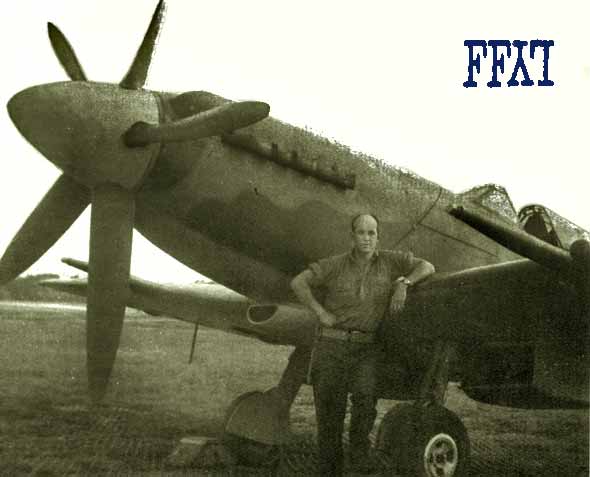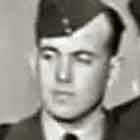|

S/L Rolly Dibnah with his 91 Squadron Spit 9, June 1944
--------------------------------------------------
|
|
Unfortunately, I have very little info about Roland Dibnah at this time.
If you have any, and don't mind sharing, don't hesitate to
me!
I have a feeling there's a story here that wants to be told.
Rolly Dibnah |
|
 |
--------------------------------------------------
From Winnipeg, Manitoba.
Enlisted in the RAF in May 1939.
Earns a Short Service Commission (#42675) as an
Acting P/O on probation on 2 September 1939.
From Acting P/O on probation to P/O on 28 Feb 1940.
In May 1940, following training at No.6 OTU,
he was posted to No. 1 Sqn. in Vassincourt, France.
Flew with 1 Sq. during the Battle of France (with Hilly Brown).
He was shot down near Nancy on May 26th, but he made it
back to the UK, & No.1 Sqn., in time for the Battle of Britain.
Transferred to 242 Squadron on 21 (15 -Allison) Sept. 1940.
There he flew with the likes of Willie McKnight & Doug Bader.
He left that unit on 30 or 31 December 1940.
Off the radar for 3 years (instructing & ??).
From P/O to F/O on 28 February 1941.
From F/O to F/L on 18 May 1942.
He was instructing at 41 OTU, Hawarden, in December 1943.
To 91 Squadron in January 1944.
Relinquished his Commission in the RAF.
Transferred to the RCAF as a S/L on 18 January 1945.
He had completed 3 tours in the RAF.
Called "Dib" "Rolly" "DeBonia" "Rip" and other nicknames.
He claimed to have the DFC & U.S. DFC
Died in February 1990 in Vancouver, B.C. |
--------------------------------------------------
Speaking of Hilly Brown - "A special dedication service was held at the school in MacGregor, Manitoba in 1982, with plaques, pictures, and original uniforms of W/C Brown. One special guest was S/L Roland Dibnah D.F.C. of Winnipeg, Manitoba, the only surviving member of #1 RAF Squadron, who flew with P/O Brown in the Battle of France. P/O Dibnah was shot down in May 1940 and missing so S/L P. Halahan wrote the Dibnah family in Winnipeg saying, “I'm sure your son is alright and I've recommended him for the D.F.C. for his superb fighting." In 1980 S/L Roland Dibnah's mother died. Roland found the original letter and sent it to RAF Headquarters in London, England. He received his D.F.C. — 40 years after the recommendation. He too was an ace with 9 enemy aircraft to his credit and flew all during the war but was never decorated. Ex Squadron Leader Roland Dibnah D.F.C. died in Feb 1990 at Vancouver, British Columbia." - From the book "They Shall Grow Not Old" by Les Allison & Harry Hayward
--------------------------------------------------
"On September 5, twenty-two different German formations attacked these targets within eight hours. In the midst of these raids, John Boyle of 41 Squadron destroyed an Me 109, as did Jack Carpenter, the transplanted navy pilot, while Roland Dibnah, one of Bader's pilots, brought down a 110.
Boyle's combat report illustrated the intensity of the day's fighting:
I was Green 3 ... patrolling between Maidstone and Ramsgate. Interception was made at 20,000 feet; enemy aircraft varying from 16,000 to 22,000 feet. Green Section attacked bombers [Do 17s] in line-astern formation. Seven or eight Me 109s were covering these bombers. Three Me 109s came in between me and Green 1 and 2. I attacked the most convenient e/a, starting to fire from above with quarter deflection closing in to dead-astern. A four or five-second burst was enough. The 109 broke up, with flame and smoke coming from the right-hand side; it immediately rolled on its back and spun.
Dibnah's unit, 242 Squadron, had been practicing take-offs and landings, and forming up with two other squadrons from Duxford. The exercise had Leigh-Mallory's full blessing as well as the hearty approval of the deputy chief of the Air Staff, Sholto Douglas. Bader had reduced squadron take-off time to three minutes, but the Wing still had to form up. Keith Park of 11 Group was not against the "Big Wing" formations per se. Far from it. At the time of Dunkirk, he had initiated their use in formations as large as four squadrons. But that was for offensive purposes when there was lots of time to form up. Not so easily done defensively.
Rarely was it possible to detect the enemy's intentions until it reached the coast, about twenty minutes' flying time from the center of London. It took all that time and more for the British fighters to reach 20,000 feet, so they had to be off the ground and climbing in a flash. For that reason Park, for the most part, confined his formations to single squadrons, two at the most, although on rare occasions this was increased to three.
Hugh Dowding said later that had Big Wings been used by 11 Group, a great many more enemy bombers would have reached their targets. Park was even more explicit: "Had I tried Bader's theories of the Big Wing," he said, "I would have lost the Battle of Britain."
From the book "Splendid Hundred" by Art Bishop
--------------------------------------------------
Victories Include :
early May 1940
30 Aug 1940
5 Sept 1940 |
1/2 Me109
one Me110
one Me110 |
destroyed*
damaged
destroyed |
1.5 - 1 / 0 / 1
Another source gives him a Stuka over Dover
* Shared with Hilly Brown (Dibnah's memory as told in "Canadians in the RCAF")
Score may be higher
--------------------------------------------------
Check out some cool pix posted at the Warbird info exchange
--------------------------------------------------
|




